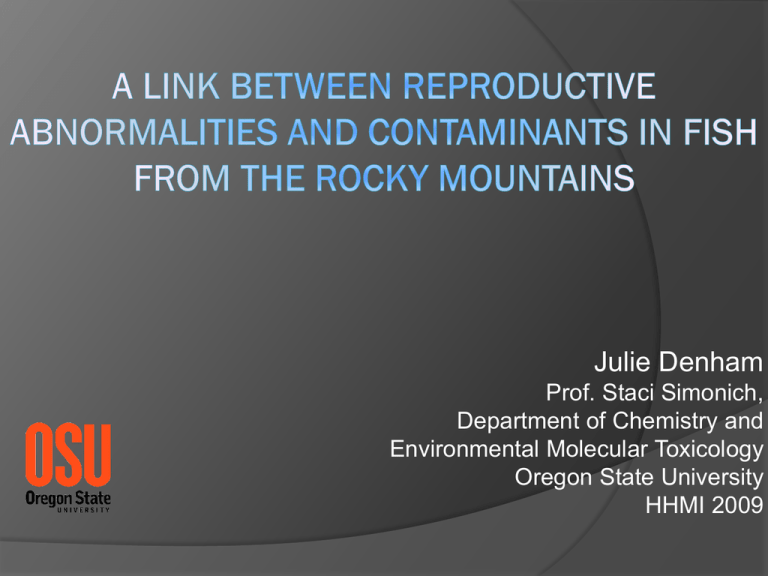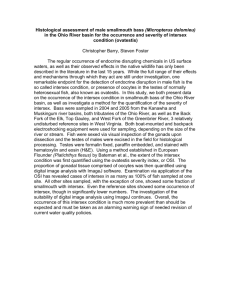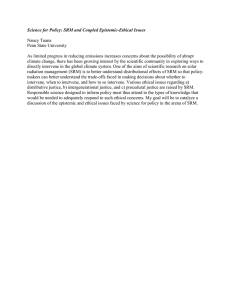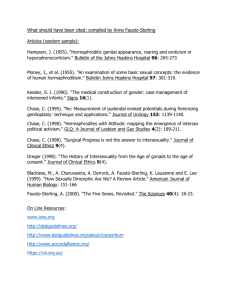Julie Denham
advertisement

Julie Denham Prof. Staci Simonich, Department of Chemistry and Environmental Molecular Toxicology Oregon State University HHMI 2009 Industrially made in the early 1930’s Short term affects eliminated agricultural problem Persistent contaminants toxic to ecosystems Linked to diseases, abnormalities, and endocrine disruption Accumulate in the ecosystem Undergo atmospheric transport Volatilize at high temperatures and condense at lower temperatures Settle remote high altitude ecosystems Contamination source Release into environment Transport Partitions into ecosystem Water Soil Tissue Atmosphere http://www.epa.gov/glnpo/atlas/glat-ch4.html Fractionate into lipids Concentrations increase through food web Fish are a useful tool of which POPs are present in the environment and the impacts they have on specific ecosystems http://io.uwinnipeg.ca/~simmons/16cm05/1116/54-25-DDTInFoodChain-L.jpg. A hormone imbalance of intersex characteristics and increased vitellogenin levels in males Intersex- an abnormality that can be found in animals containing both sexual reproductive organs Vitellogenin (VG)- a protein synthesized in the liver in reaction to excess estrogen levels - precursor for egg-yolk synthesis Developing vitellogenic eggs Spermatocysts with spermatogonia Reproductive Abnormalities in Trout from Western U.S. National Parks. Schwindt, A. R., et al. Previous research showed: • Signs of intersex fish in Rocky Mountain Nat. Park • Pesticide concentrations highest among the Western National parks •Black Circles Containing white numbers represent 2003-2006 sampling • White circles are historic samples collected from 1800’s- 1934 Reproductive Abnormalities in Trout from Western U.S. National Parks. Schwindt, A. R., et al. • Highest Concentration • One currently in use • Four compounds are xenoestrogens p,p-DDE Dieldrin trans-Nonachlor PCB’s Dacthal Hexachlorobenzene (HCB) Endosulfan Sulfate Xenoestrogens organic compounds that have estrogen like affects • Not produced as a natural hormone p,p-DDE Dieldrin • Cause excess vitellogenin concentrations PCB’s Endosulfan Sulfate Measure POPs in fish samples collected previously To interpret the POP concentrations in the fish with respect to intersex. The accumulation of persistent organic pollutants in male trout of remote high altitude lakes caused intersex characteristics. Fish Homogenate X g Fish + X g Na2SO4 Extraction of analytes (ASE) Removal of polar compounds (SPE) Fraction 1 Fraction 2 (target analytes) (archived for recovery) Gel permeation chromatography Fraction A: lipid archive Fraction B: target analytes Quantification of target analytes GCMS Use of certified Standard Reference Material (SRM) SRM is certified by NIST to have a known value of pesticides Used in analytical methods for precision and accuracy SRM 1946 - Lake Superior Trout tissue - Certified concentrations for chlorinated pesticides and PCBs Performed Average in Triplicate concentrations of triplicate data were compared to the known quantities in SRM samples - standard deviation of Triplicate vs. SRM known values -In SRM and previous studies from Rocky Mountain National Park p,p-DDE Dieldrin trans-Nonachlor PCB’s Dacthal Hexachlorobenzene (HCB) Finish extracting pesticides from intersex and control male fish Analysis on GC/MS to quantify the concentrations of POPs Use of statistical correlations between the POPs and intersex to determine if a relationship exists Dr. Staci Simonich Howard Hughes Medical Institute Simonich labJill, Jessica, Wentao, Carlos, Leah, On, & Dr. Steve Sylvester Dr. Kevin Ahern National Park Service Oregon State University Department of EMT Family and Friends



